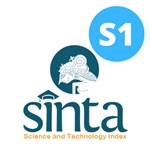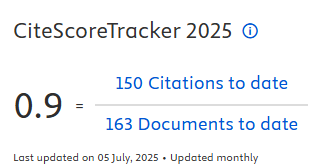The Correlation between Working Period and Exercise Routines with Musculoskeletal Complaints on Batik Craftsmen

Downloads
Introduction: Asosiasi untuk Demokrasi dan Kesejahteraan Sosial (Ademos) was founded as a form of anxiety towards rural communities whose majority of the population does not receive enough attention and access to economic development. One of the empowerment programs is a program to improve the quality of the Bojonegoro batik craftsmen. Workers can work more than 8 hours a day in a sitting and bending position for long periods of time. This study aimed to determine the correlation between the length of work and exercise routines on musculoskeletal complaints among batik craftsmen of Ademos, Bojonegoro Regency. Methods: This research was a descriptive analytic study using a cross-sectional design. The research was conducted in July-August 2020 on Ademos batik craftsmen in Bojonegoro Regency. The total population of the study was 42 batik craftsmen who were selected using a total sampling technique. The variables studied included tenure, exercise routines, and musculoskeletal complaints. Data collection was carried out through questionnaire sheets, observations and the Nordic Body Map Questionnaire. Results: The results of the study found that there was a significant correlation between working period and musculoskeletal complaints (p=0.032) experienced by Batik craftsmen of Ademos Bojonegoro. On the other hand, there was no correlation found between exercise routines and musculoskeletal complaints (p=0.361) on Batik craftsmen of Ademos Bojonegoro. Conclusion: The significant factor causing musculoskeletal complaints in Ademos Bojonegoro Batik craftsmen was the working period factor.
Anas, A., Ulfah, N. and Harwanti, S. (2013) ‘Determinan yang Berhubungan dengan Keluhan Musculosceletal Disorders (MSDs) pada Pekerja Industri Genteng di Kecamatan Petahanan Kabupaten Kebumen', Jurnal Kesmasindo, 6(2), pp. 110–116.
Djaali, N. A. and Utami, M. P. (2019) ‘Analisis Keluhan Musculosceletal Disorders (MSDs) pada Karyawan PT. Control System Arena Para Nusa', Jurnal Ilmiah Kesehatan, 11(1), pp. 80–87.
Evadarianto, N. and Dwiyanti, E. (2017) ‘Postur Kerja dengan Keluhan Musculoskeletal Disorders pada Pekerja Manual Handling Bagian Rolling Mill', The Indonesian Journal of Occupational Safety and Health, 6(1), pp. 97–106.
Hanif, A. (2020) ‘Hubungan antara Umur dan Kebiasaan Merokok dengan Keluhan Musculosceletal Disorders (MSDs) pada Pekerja Angkat Angkut UD Maju Makmur Kota Surabaya', Medical Technology and Public Health Journal, 4(1), pp. 7–15.
Helmina, Diani, N. and Hafifah, I. (2019) ‘Hubungan Umur, Jenis Kelamin, Masa Kerja dan Kebiasaan Olahraga dengan keluhan Musculoskeletal Disorders (MSDs) pada Perawat', Caring Nursing Jounal, 3(1), pp. 23–30¬.
Karima, A. N. A., Idayanti and Umar, A. (2018) ‘Pengaruh Masa Kerja, Pelatihan dan Motivasi terhadap Produktivitas Kerja Karyawan pada PT.Bank Sulselbar Cabang Utama Makassar', Hasanuddin Journal of Applied Business and Entrepreneurship, 1(1), pp. 49–64.
Komarliawati, M., Djojosugito, A. and Nurhayati, E. (2019) ‘Hubungan Masa Kerja dengan Keluhan Muskuloskeletal pada Buruh Angkut LPG di PT X Tahun 2018', Prosiding Pendidikan Dokter, 5(1), pp. 56–62.
Prabarukmi, G. S. and Widajati, N. (2020) ‘The Correlation of Ergonomic Risk Factor with Musculoskeletal Complaints in Batik Workers', The Indonesian Journal of Occupational Safety and Health, 9(3), pp. 269–278.
Saputro, C. B., Mulyono, M. and Puspikawati, S. I. (2019) ‘Hubungan Karakteristik Individu Dan Sikap Kerja Terhadap Keluhan Muskuloskeletal Pada Pengrajin Batik Tulis', Journal of Public Health Research and Community Health Development, 2(1), pp. 1–10.
Savitri, I. W. and Sumekar, T. A. (2015) ‘Hubungan antara Aktivitas Membatik dengan Gangguan Muskoloskeletal pada Pengrajin Batik Tulis', Media Medika Muda, 4(4), pp. 985–995.
Shobur, S., Maksuk, M. and Sari, F. I. (2019) ‘Faktor Risiko Musculosceletal Disorders (MSDs) pada Pekerja Tenun Ikat di Kelurahan Tuan Kentang Kota Palembang', Jurnal Medikes (Media Informasi Kesehatan), 6(2), pp. 113–122.
Suma'mur, P. K. (2009) Higiene Perusahaan dan Kesehatan Kerja. Cetakan ke sembilan. Jakarta: Sagung Seto.
Tarwaka (2015) Ergonomi Industri: Dasar-Dasar Pengetahuan Ergonomi Dan Aplikasi di Tempat Kerja. II. Surakarta: Harapan Press.
Tjahayuningtyas, A. (2019) ‘Factors Affecting Musculosceletal Disorders (MSDs) in Informal Workers', The Indonesian Journal of Occupational Safety and Health, 8(1), pp. 1–10.
Utami, U., Karimuna, S. and Jufri, N. (2017) ‘Hubungan Lama Kerja, Sikap Kerja dan Beban Kerja Dengan Muskuloskeletal Disorders (MSDs) pada Petani Padi di Desa Ahuhu Kecamatan Meluhu Kabupaten Konawe Tahun 2017', Jurnal Ilmiah Mahasiswa Kesehatan Masyarakat Unsyiah, 2(6), pp. 1–10.
Viswanatha, P. A. and Adiatmika, I. P. G. (2020) ‘Hubungan Rutinitas Olahraga dengan Gangguan Muskuloskeletal pada Pegawai Fakultas Kedokteran Universitas Udayana', Jurnal Medika Udayana, 9(2), pp. 36–40.
Copyright (c) 2022 The Indonesian Journal Of Occupational Safety and Health

This work is licensed under a Creative Commons Attribution-NonCommercial-ShareAlike 4.0 International License.

In order to be accepted and published by The Indonesian Journal of Occupational Safety and Health, Author(s) who submit an article should complete all the review process. The copyright of received articles assigned to the The Indonesian Journal of Occupational Safety and Health and Department of Safety and Health, Universitas Airlangga as publishers of the journal. The intended copyright includes the rights to publish articles in various forms (including reprints).
The Editorial Team of The Indonesian Journal Of Occupational Safety and Health and Department of Safety and Health strive to ensure that no errors occur in the articles that have been published, both data errors and statements in the article.
Users of this website will be licensed to use materials from this website following the Creative Commons Attribution-NonCommercial-ShareAlike 4.0 International License. No fees charged. Please use the materials accordingly.
------------------------------------------------------------------------------------------------------------------------------------------------------------------------------------------
Attribution ” You must give appropriate credit, provide a link to the license, and indicate if changes were made. You may do so in any reasonable manner, but not in any way that suggests the licensor endorses you or your use.
NonCommercial ” You may not use the material for commercial purposes.
ShareAlike ” If you remix, transform, or build upon the material, you must distribute your contributions under the same license as the original.







 How to Submit Articles in OJS
How to Submit Articles in OJS

























